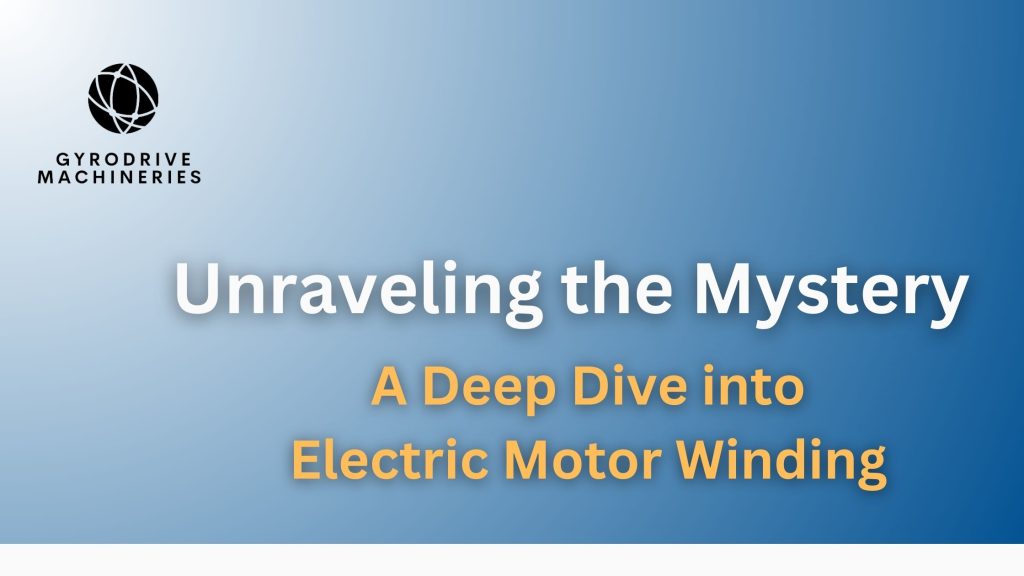Unraveling the Mystery: A Deep Dive into Electric Motor Winding
 You may not give much thought to the intricate mechanisms behind the hum of your electric appliances, but the heart of any electric motor lies in its winding. Electric motor winding, specifically the winding of the stator and rotor, is a crucial aspect that determines the performance and efficiency of the motor. Let’s take a journey into the fascinating world of electric motor winding and unravel the complexities that power our everyday devices.
You may not give much thought to the intricate mechanisms behind the hum of your electric appliances, but the heart of any electric motor lies in its winding. Electric motor winding, specifically the winding of the stator and rotor, is a crucial aspect that determines the performance and efficiency of the motor. Let’s take a journey into the fascinating world of electric motor winding and unravel the complexities that power our everyday devices.
The Basics: What is Motor Winding?
At its core, motor winding involves the careful arrangement of copper or aluminum wires around the stator and rotor cores within an electric motor. This winding creates electromagnetic fields that are essential for the motor’s operation. In simple terms, it’s like the intricate dance of a spider weaving its web, where each strand plays a vital role in ensuring the web’s strength and functionality.
Stator Winding: Crafting the Foundation
The stator is the stationary part of the motor, and its winding is responsible for creating a magnetic field that interacts with the rotor to generate motion. Picture it as the foundation of a building – without a solid base, the structure would crumble. Similarly, the stator winding sets the stage for the entire motor’s performance.
Precise winding patterns and the number of turns in each coil determine the magnetic field strength, affecting the motor’s torque and speed capabilities. Engineers meticulously calculate these parameters to ensure optimal performance for various applications, from the gentle hum of a fan to the robust power of an industrial motor.
Rotor Winding: Bringing Motion to Life
On the other hand, the rotor is the rotating part of the motor, and its winding is equally crucial. Think of the rotor winding as the gears in a clock, each tooth fitting precisely to keep time moving forward. In the motor realm, rotor winding is responsible for responding to the magnetic field generated by the stator, converting it into mechanical motion.
The winding configuration on the rotor is often designed to enhance efficiency and reduce energy losses. Engineers leverage different winding techniques, such as lap winding or wave winding, to optimize the motor’s performance based on specific requirements. This meticulous crafting ensures that your electric motor runs smoothly and efficiently, whether it’s powering your blender or propelling an electric vehicle.
Challenges in Motor Winding: Striking the Right Balance
While motor winding is a well-established science, it comes with its own set of challenges. Achieving the perfect balance between wire size, insulation, and coil configuration is akin to finding the right recipe for a gourmet dish. Too much or too little of any ingredient can impact the motor’s efficiency and longevity.
Overheating is a common concern in electric motors, and improper winding can exacerbate this issue. Engineers must carefully consider thermal conductivity and insulation properties to prevent the motor from becoming a hotbed of problems. Striking this delicate balance ensures that your motor operates optimally without burning out prematurely.
Innovation in Motor Winding: Beyond the Basics
As technology advances, so does the science of motor winding. Innovations in materials, such as the introduction of high-temperature superconductors, promise to revolutionize the efficiency and performance of electric motors. These superconductors, which can carry electric current with little to no resistance, have the potential to significantly reduce energy losses in motor winding.
Additionally, advancements in automated winding processes, guided by artificial intelligence, are streamlining production and improving consistency. This not only enhances the overall quality of electric motors but also contributes to cost-effectiveness in manufacturing.
Conclusion: The Art and Science of Motor Winding
In the grand symphony of electric motors, the winding section plays a crucial role, orchestrating the dance of electromagnetic forces that powers our modern lives. Understanding the intricacies of motor winding unveils the craftsmanship behind these silent workhorses, transforming electrical energy into the kinetic motion that drives our appliances and machinery. So, the next time you switch on your favorite gadget, take a moment to appreciate the winding marvels within, silently propelling the world into motion.
To know more about our products click here

Leave a Reply